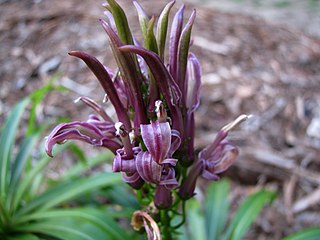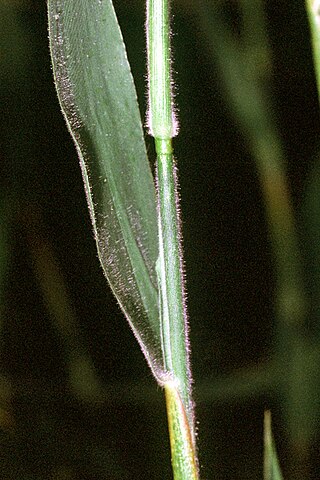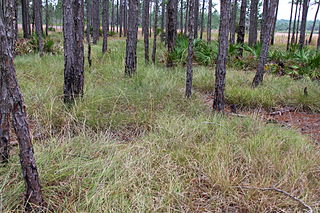
Niʻihau, anglicized as Niihau, is the westernmost main and seventh largest inhabited island in Hawaii. It is 17.5 miles (28.2 km) southwest of Kauaʻi across the Kaulakahi Channel. Its area is 69.5 square miles (180 km2). Several intermittent playa lakes provide wetland habitats for the Hawaiian coot, the Hawaiian stilt, and the Hawaiian duck. The island is designated as critical habitat for Brighamia insignis, an endemic and endangered species of Hawaiian lobelioid. The United States Census Bureau defines Niʻihau and the neighboring island and State Seabird Sanctuary of Lehua as Census Tract 410 of Kauai County, Hawaii. Its 2000 census population was 160, most of whom are native Hawaiians; Its 2010 census population was 170. At the 2020 census, the population had fallen to 84.

Omiodes demaratalis, the Hawaiian grass leafroller, is a species of moth in the family Crambidae. It is endemic to the Hawaiian islands of Niihau, Kauai, Oahu, Molokai, Maui and Hawaii.

Panicum hirticaule is a species of grass known by the common names Mexican panicgrass and roughstalked witchgrass. It is also known as the Sonoran millet, and is cultivated as a cereal crop in the American Southwest.

Cyanea remyi is a rare species of flowering plant in the bellflower family known by the common name Remy's cyanea. It is endemic to Hawaii, where it is known only from the island of Kauai. It is a federally listed endangered species of the United States. Like other Cyanea, it is known as haha in Hawaiian.

Cyperus trachysanthos is a rare species of sedge known by the common names pu`uka`a and sticky flatsedge. It is endemic to Hawaii, where it is known from Kauai and Oahu. It was known from Niihau, Molokai and Lanai, but it has been extirpated from these islands. It is a federally listed endangered species of the United States.

Cyrtandra cyaneoides is a rare species of flowering plant in the African violet family known by the common name māpele. It is endemic to Kauaʻi in Hawaiʻi, where it is known from eleven populations containing a total of under 800 individual plants. Several of these were discovered between 2003 and 2008. It is a shrub that grows 1 to 6 meters tall, bears white flowers, and egg-shaped berries. It was federally listed as an endangered species in 1996.
Cyrtandra oenobarba is a rare species of flowering plant in the African violet family known by the common name shaggystem cyrtandra. It is endemic to Hawaii, where it is known only from the island of Kauai. It can be found in only three localized areas of the island and there are fewer than 500 individuals remaining in the wild. It was federally listed as an endangered species in 2010. Like other Hawaiian Cyrtandra it is called ha`iwale.

Diplazium molokaiense is a rare species of fern known by the common name Molokai twinsorus fern. It is endemic to Hawaii, where it is one of the rarest ferns. It has historically been found on the islands of Kauai, Oahu, Lanai, Molokai, and Maui, but it is thought to have been extirpated from four of them and today can be found only on Maui where fewer than 70 individual plants remain. The fern was federally listed as an endangered species of the United States in 1994.
Phlegmariurus mannii, synonym Huperzia mannii, is a species of lycopod, known by the common names Mann's clubmoss and wawaeʻiole. It is endemic to Hawaii, where there are only six populations remaining. It is a federally listed endangered species of the United States.

Lobelia niihauensis, commonly known as the Niihau lobelia, is a rare species of flowering plant in the bellflower family that is endemic to Hawaii. It is known only from the islands of Oʻahu and Kauaʻi and is thought to be extirpated from Niʻihau. It is federally listed as an endangered species of the United States.

Cyperus pennatiformis is a rare species of sedge known by the common name coastal flatsedge. It is endemic to Hawaii, where it grows on the islands of Maui, Kauai, and Laysan. It is a federally listed endangered species of the United States.
Peristylus holochila is a rare species of orchid known by the common name Hawaii bog orchid. It is endemic to Hawaii. It is a federally listed endangered species of the United States.
Poa mannii is a rare species of grass known by the common names Mann's bluegrass and Olokele Gulch bluegrass. It is endemic to Hawaii, where it is limited to the island of Kauai. It is threatened by the loss and modification of its habitat. It is a federally listed endangered species of the United States.
Poa sandvicensis is a rare species of grass known by the common name Hawaiian bluegrass. It is endemic to Hawaii, where it is limited to the island of Kauai. It is threatened by the loss and modification of its habitat. It is a federally listed endangered species of the United States.
Poa siphonoglossa is a rare species of grass known by the common names Kauai bluegrass and island bluegrass. It is endemic to Hawaii, where it is limited to the island of Kauai. It is threatened by the loss and modification of its habitat. It is a federally listed endangered species of the United States.

Silene lanceolata is a rare species of flowering plant in the family Caryophyllaceae known by the common names Kauai catchfly and lanceolate catchfly. It is endemic to Hawaii, where it is known only from Oahu, Molokai, and Hawaii, having been extirpated from Kauai and Lanai. It is threatened by the degradation of its habitat and it is a federally listed endangered species of the United States.

Vigna owahuensis is a rare species of flowering plant in the legume family known by the common name Oahu cowpea.

Dichanthelium scoparium is a species of grass known by the common names velvet panicum, velvety panicgrass, and broom panicgrass. It is native to North America, where it occurs in the southeastern United States. It also occurs in the West Indies.

Panicum abscissum is a species of grass known by the common name cutthroat grass. It is endemic to Florida in the United States. It is limited to five counties in the central Florida peninsula.

Panicum anceps is a species of grass known by the common name beaked panicgrass. It is native to the southeastern United States, where it occurs as far north as New Jersey and as far west as Kansas and Texas.















